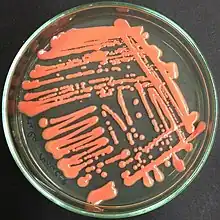Sporidiobolales
The Sporidiobolales are an order of fungi in the subdivision Pucciniomycotina. The order contains a single family, the Sporidiobolaceae, which currently contains three genera.[1] Most species are known only from their yeast states. Hyphal states produce teliospores from which auricularioid (tubular and laterally septate) basidia emerge, bearing basidiospores. Species occur worldwide and have been isolated (as yeasts) from a wide variety of substrates. Two species, Rhodotorula mucilaginosa and R. glutinis, have been known to cause disease in humans.[2]
| Sporidiobolales | |
|---|---|
 | |
| Rhodotorula mucilaginosa colonies on yeast extract glucose chloramphenicol agar (YGC). | |
| Scientific classification | |
| Domain: | Eukaryota |
| Kingdom: | Fungi |
| Division: | Basidiomycota |
| Class: | Microbotryomycetes |
| Order: | Sporidiobolales Doweld (2001) |
| Family: | Sporidiobolaceae R.T. Moore (1980) |
| Genera | |
|
Rhodosporidiobolus | |
References
- Wang Q, Yurkov AM, Göker M, Lumbsch HT, Leavitt SD, Groenewald M, Theelen B, Liu X, Boekhout T, Bai F (2016). "Phylogenetic classification of yeasts and related taxa within Pucciniomycotina". Studies in Mycology. 81: 149–189. doi:10.1016/j.simyco.2015.12.002. PMC 4777780. PMID 26951631.
- Zaas AK, Boyce M, Schell W, Lodge BA, Miller JL, Perfect JR (November 2003). "Risk of fungemia due to Rhodotorula and antifungal susceptibility testing of Rhodotorula isolates". Journal of Clinical Microbiology. 41 (11): 5233–5. doi:10.1128/jcm.41.11.5233-5235.2003. PMC 262498. PMID 14605170.
This article is issued from Wikipedia. The text is licensed under Creative Commons - Attribution - Sharealike. Additional terms may apply for the media files.